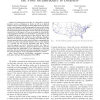Free Online Productivity Tools
i2Speak
i2Symbol
i2OCR
iTex2Img
iWeb2Print
iWeb2Shot
i2Type
iPdf2Split
iPdf2Merge
i2Bopomofo
i2Arabic
i2Style
i2Image
i2PDF
iLatex2Rtf
Sci2ools
INFOCOM
2009
IEEE
2009
IEEE
Assessing the Vulnerability of the Fiber Infrastructure to Disasters
—Communication networks are vulnerable to natural disasters, such as earthquakes or floods, as well as to physical attacks, such as an Electromagnetic Pulse (EMP) attack. Such realworld events happen in specific geographical locations and disrupt specific parts of the network. Therefore, the geographical layout of the network determines the impact of such events on the network’s connectivity. In this paper, we focus on assessing the vulnerability of (geographical) networks to such disasters. In particular, we aim to identify the most vulnerable parts of the network. That is, the locations of disasters that would have the maximum disruptive effect on the network in terms of capacity and connectivity. We consider graph models in which nodes and links are geographically located on a plane, and model the disaster event as a line segment or a circular cut. We develop algorithms that find a worstcase line segment cut and a worst-case circular cut. Then, we obtain numerical results fo...
| Added | 24 May 2010 |
| Updated | 24 May 2010 |
| Type | Conference |
| Year | 2009 |
| Where | INFOCOM |
| Authors | Sebastian Neumayer, Gil Zussman, Reuven Cohen, Eytan Modiano |
Comments (0)

